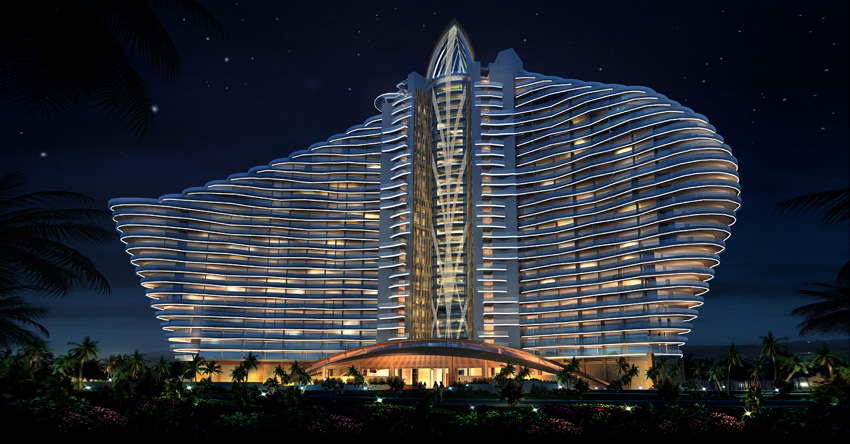We have completely broken away from the old pattern of traditional hospitals, created a brand-new green hospital image and an emotionally healthy rehabilitation environment, and embodied our equal care for medical staff, patients and visitors. This can not only meet the demand of a rational division and coordination among various building parts, but also maintain a highly unified architectural form and spatial manifestation, that is, the high unification of functions and form.
With the rapid development and evolution of the medical industry both at home and abroad, more challenges and uncertain factors are posing themselves in the construction and development process of hospitals. Thus, the design of this scheme has applied the planning & design ideas of “flexibility and development” and “module combination”, so as to realize the high flexibility and sustainable development of The First Affiliated Hospital of Zhengzhou University in the future and adapt to the developmental trends of modern hospitals. With regard to the geological location of the construction site and its surrounding architectural environment and landscape environment, various complicated factors on site have been analyzed and integrated, with an emphasis on urban design. Through carefully analyzing the relationship between the surrounding environment and the medical buildings on site, a diversified range of methods have been adopted to provide a positive response in terms of planning layout, architectural styling and landscape environment design.
The optimal design standard on modern hospitals has been proposed on a specific basis, and, some modern hospital design techniques have also been incorporated based on a rational functional partition; advanced medical equipment, architectural system and information management technology have been introduced, emphasizing the creation of a high-efficiency medical service pattern in the hospital.
The project is characterized by a clear division of functions, concise and direct flow lines and explicit orientations, and has clearly defined its public space, medical space and patient space. Besides realizing the design goals of this project, necessary conditions have also been provided for the high-efficiency operation of the hospital.
Considering the relatively small floor area of the base, after a full analysis on the nature of the base and on its relationship with nearby roads, efforts are made to arrange the building in the southeast of the base as far as possible, so as to maximize the square in front of the building. The front square adopts the separation of pedestrians and vehicles, and sets the lanes on the original north-south and east-west roads in the hospital which are connected with it. The front square, the overhead square and the central garden join together to form an integral pedestrian area, connects outpatient and inpatient pedestrian flows in space, and strengthens the sense of wholeness of the hospital.
The 3D geometric image of architectural modeling represents a continuation of the general layout, and especially emphasizes the sense of space and sense of massing of the building; the combinations of concise structures and thick entities and sun louvers not only create the characteristics of unification and harmony with existing buildings, but also builds the new architectural image of a high-quality hospital with a strong modern sense.
With the rapid development and evolution of the medical industry both at home and abroad, more challenges and uncertain factors are posing themselves in the construction and development process of hospitals. Thus, the design of this scheme has applied the planning & design ideas of “flexibility and development” and “module combination”, so as to realize the high flexibility and sustainable development of The First Affiliated Hospital of Zhengzhou University in the future and adapt to the developmental trends of modern hospitals. With regard to the geological location of the construction site and its surrounding architectural environment and landscape environment, various complicated factors on site have been analyzed and integrated, with an emphasis on urban design. Through carefully analyzing the relationship between the surrounding environment and the medical buildings on site, a diversified range of methods have been adopted to provide a positive response in terms of planning layout, architectural styling and landscape environment design.
The optimal design standard on modern hospitals has been proposed on a specific basis, and, some modern hospital design techniques have also been incorporated based on a rational functional partition; advanced medical equipment, architectural system and information management technology have been introduced, emphasizing the creation of a high-efficiency medical service pattern in the hospital.
The project is characterized by a clear division of functions, concise and direct flow lines and explicit orientations, and has clearly defined its public space, medical space and patient space. Besides realizing the design goals of this project, necessary conditions have also been provided for the high-efficiency operation of the hospital.
Considering the relatively small floor area of the base, after a full analysis on the nature of the base and on its relationship with nearby roads, efforts are made to arrange the building in the southeast of the base as far as possible, so as to maximize the square in front of the building. The front square adopts the separation of pedestrians and vehicles, and sets the lanes on the original north-south and east-west roads in the hospital which are connected with it. The front square, the overhead square and the central garden join together to form an integral pedestrian area, connects outpatient and inpatient pedestrian flows in space, and strengthens the sense of wholeness of the hospital.
The 3D geometric image of architectural modeling represents a continuation of the general layout, and especially emphasizes the sense of space and sense of massing of the building; the combinations of concise structures and thick entities and sun louvers not only create the characteristics of unification and harmony with existing buildings, but also builds the new architectural image of a high-quality hospital with a strong modern sense.






